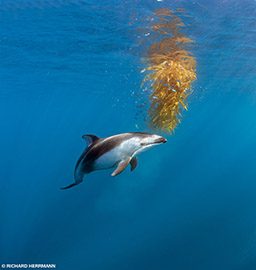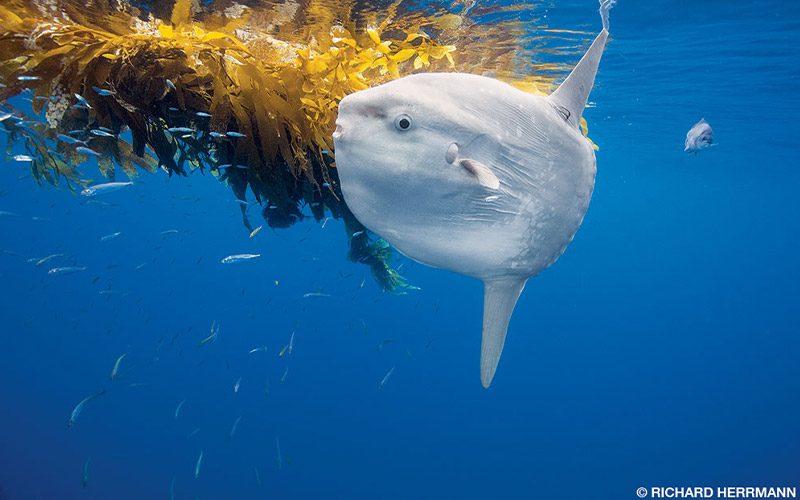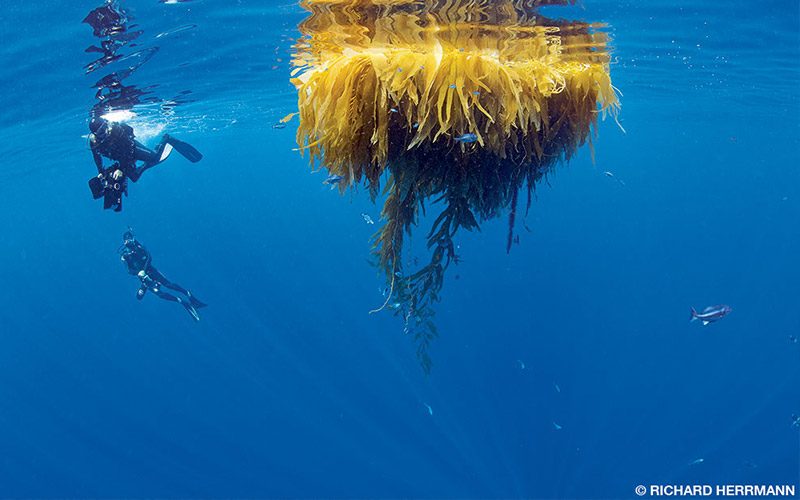I was in a small boat about 30 miles offshore of San Diego, Calif., looking for life. We were running hard at 20 knots when out of the corner of my eye I caught a glimpse of a tiny patch of brown against the vast blue background. It was a bit of kelp about the size of a trashcan lid. I turned toward it and immediately saw a huge splash and a distressed yellowfin tuna doing tight circles around the kelp. Here was a picture I had wanted for years: a tuna on a kelp paddy.
When I got into the water I saw what had made that big splash as the form of a massive 400- to 500-pound blue marlin materialized out of the blue. The lightbulb went off immediately, and I knew why the big marlin was there — the more commonly seen striped marlin does not prey on 20- to 30-pound tuna.
That day I got images of the blue marlin and the tuna (see Parting Shot, Alert Diver, Winter 2015). These were likely the first-ever underwater photos of a blue marlin taken in California waters. It was among the two or three best days I have ever had in 35 years of diving kelp paddies.
That happened in the fall of 2014, which was the beginning of a series of warming years that included the very powerful 2015 El Niño. The warming events of 2014, 2015 and 2016 have brought to the California coast warm-water species from the south that had rarely been seen over the years, and all of them were observed around kelp paddies.
What is a Kelp Paddy?
Searching for photographic subjects in the big blue void of the open sea can be frustrating. Signs of life are fleeting. The subtle splash of a marine mammal or working birds are among the few signs that indicate the possibility of life.

Much like the Atlantic coast, which has its own drifting algae habitat (Sargassum), the Pacific coast of North America has drifting kelp. Giant kelp (Macrocystis) grows from Alaska to central Baja California. Kelp paddies form when the anchoring kelp holdfast weakens and breaks free after storms, warming events or grazing by sea urchins. As the 80-foot-tall plants drift away, they become entangled with other kelp plants. Buoyed to the surface by gas-filled bladders, these floating masses are then swept out to sea by wind and currents. An average-sized kelp paddy might be the size of a bathtub, but they can be more than 50 feet across with holdfasts dangling down 40 feet. Kelp paddies can be found any time of the year with locations varying from just a mile or so off the coast to hundreds of miles out to sea. Most kelp paddies drifting off the California coast originate from the beds of giant kelp in the Channel Islands or elsewhere along the West Coast.
Best described as “drifting islands of life,” kelp paddies provide a refuge for planktonic fishes and invertebrates that initially settle in the ready-made habitat. Small fishes and invertebrates attract schooling baitfish such as sardines and mackerel. Larger predators such as tuna, marlin, sharks and marine mammals complete the food chain as they come to feed on the baitfish. The entire range of large pelagic predators found on the Pacific coast can be seen near kelp paddies. When the larger predators appear, juvenile fishes can retreat within the protection of the tangled plant mass.
The assemblage of animals found in association with kelp drifting off the Pacific coast cannot be found anywhere else in the world. For example, the juvenile stage of the splitnose rockfish (Sebastes diploproa) has only been observed under drifting kelp. The adult form of this rockfish is found in very deep water from 700 to 1,500 feet. Drifting kelp may also be an important habitat for the juvenile stage of the California yellowtail, halfmoon and other species of fishes. Marine scientists sampling kelp paddies have found more than 25 different species of fishes amid kelp paddies, with most of the species consisting entirely of juveniles.
You never know what you are going to see under the kelp; populations vary from year to year and area to area. An area of 65°F water may have a completely different set of animals than an area of 72°F water just five miles away. That’s what makes kelp paddies so interesting.
The recent warm years have brought smooth hammerhead sharks, blue marlin, bluefin tuna, false orcas and many other species that were rare in previous years. Until the summer of 2014, for example, wahoo had never been documented in California waters, but in the strong 2015 El Niño event, more than 1,000 wahoo were caught in California waters by sport fishermen.
Mola Mola

Kelp paddies are absolutely the best place to find Mola mola. Molas, which come to the drifting kelp to be cleaned by the halfmoon fish, are loaded with parasites, both externally and internally. We saw one mola that was particularly undisturbed by diver presence and were able to pull out parasitic copepods deeply embedded in its skin. The fish actually seemed to enjoy the encounter.
It is not unusual to see up to three molas on a drifting kelp. My personal record from a few years ago was 50 adult molas on a single kelp paddy. They are generally wary of photographers approaching them at the surface or from underwater. A diver in a black wetsuit looks like a sea lion to the mola. I have seen sea lions tear apart molas, so it is important to approach slowly and not aggressively. Some molas may not care much about an approaching diver, but it is more common for them to swim away.
Diving Kelp Paddies
Kelp paddies are best dived by live boating, with a driver staying aboard. Tying up to the kelp usually pulls it apart, and anchoring or mooring is impossible because of the water depth (typically 1,000 to 3,000 feet). Stay aware because fishermen looking for pelagic gamefish also target kelp paddies. On a few occasions I’ve seen fishermen cast jigs at the drifting kelp with divers in the water.

For this reason the vessel should fly a dive flag, and the boat driver should carefully monitor the location of the kelp and the divers at all times. It is also best to live boat upwind of the divers. Weather can change quickly, and a vessel that gets downwind and loses power could become a liability for a diver who has to swim and catch up to the rapidly disappearing vessel. With only a speck of brown for reference against a vast blue background, it is easy for the boat driver to lose visual on a kelp paddy. Taking this into account, divers should carry a surface marker buoy, whistle, strobe and a diver’s emergency position indicating radiobeacon (EPIRB) of some sort.
In recent years crews have filmed the kelp paddy story for IMAX, BBC, National Geographic and Silverback Films. My most memorable filming project of a kelp paddy was one in which Howard Hall coordinated our five-man crew underwater to position a 1,400-pound IMAX 3-D camera with cable lights to successfully film multiple Mola mola at a cleaning station. Finding and exploring kelp paddies takes some time and effort, but it’s worth it to see what lies beneath them.
© Alert Diver — Q4 Fall 2016